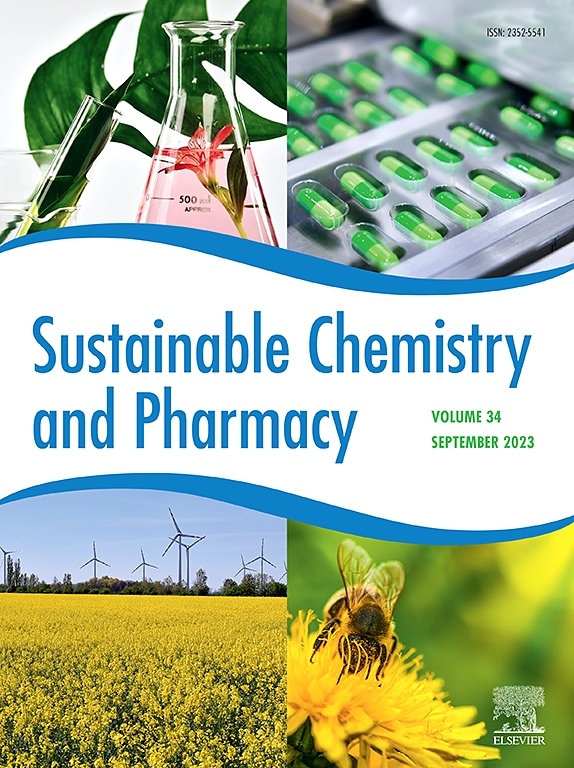A comparative study on recovery and recycle of acid dye and silk fibroin from colored waste silk textiles through dye stripping and silk dissolution
IF 5.5
2区 化学
Q2 CHEMISTRY, MULTIDISCIPLINARY
引用次数: 0
Abstract
Effective recovery of dyes from discarded textiles is essential for energy conservation and environmental protection. This study explores recovery of acid dye from waste silk textiles through dye stripping and silk dissolution. Silk, wool and nylon fabrics were dyed with the recovered dye to explore optimal dyeing condition and the re-dyeing performance. A comparative analysis of the two recovery methods highlights their respective dyeing efficiencies and practical viability. Results show that dye stripping rate from fabric decolorization reaches 86 % when 50 % ethanol is used. An optimal dye uptake of over 95 % can be achieved when re-dyeing silk, wool and nylon with stripping dye. While fabric dye uptake from dissolved dye is relatively low (around 70 %), protein in the dissolved solution can play a certain role in modifying surface of the dyed fabric and in acting as leveling agent to ensure uniform coloration. A comparison of ternary solution of CaCl2/ethanol/water and LiBr as silk dissolving agent reveals similar dyeing effects, with the ternary solution emerging as the more cost-effective alternative due to its significantly lower price. The printed patterns on cotton with regenerated colored protein from dissolved silk are vivid, sharp, and well-defined, exhibiting satisfactory colorfastness at protein content of 15 %. The successful application of recovered acid dye on cotton expands its potential use beyond traditional protein-based textiles. Both dye recovering methods employed in this study are simple, green and economical. The recovered dyes are able to retain the original dye structure. These findings provide valuable insights into a sustainable recovery and reuse of dyes from discarded textiles, offering practical implications for eco-friendly dyeing/printing practices and colored waste textile recycling.

用染料剥离法和溶丝法对彩色废丝绸中酸性染料和丝素进行回收再利用的比较研究
有效回收废旧纺织品中的染料是节能环保的重要手段。本研究以废丝织物为原料,采用脱染法和溶丝法回收酸性染料。用回收染料对真丝、羊毛和尼龙布进行染色,探索最佳染色条件和再染色性能。对两种回收方法进行了对比分析,突出了各自的染色效率和实际可行性。结果表明,当乙醇用量为50%时,织物脱色脱染率可达86%。当用剥离染料对丝绸、羊毛和尼龙进行再染色时,可达到95%以上的最佳染色吸收率。而溶解染料对织物染料的吸收率相对较低(约70%),溶解溶液中的蛋白质可以对染色织物表面起到一定的修饰作用,并起到调平剂的作用,保证染色均匀。通过比较CaCl2/乙醇/水三元溶液和LiBr作为蚕丝溶出剂的染色效果,发现其具有相似的染色效果,并且由于其价格明显较低,三元溶液成为更具成本效益的替代方案。用溶丝再生彩色蛋白在棉上的印花图案,在蛋白质含量为15%时,图案生动、清晰、轮廓分明,具有令人满意的色牢度。回收酸性染料在棉花上的成功应用,扩大了其在传统蛋白质纺织品之外的潜在用途。本研究采用的两种染料回收方法都简单、环保、经济。回收的染料能够保持原有的染料结构。这些发现为从废弃纺织品中可持续回收和再利用染料提供了有价值的见解,为环保染色/印刷实践和彩色废纺织品回收提供了实际意义。
本文章由计算机程序翻译,如有差异,请以英文原文为准。
求助全文
约1分钟内获得全文
求助全文
来源期刊

Sustainable Chemistry and Pharmacy
Environmental Science-Pollution
CiteScore
8.20
自引率
6.70%
发文量
274
审稿时长
37 days
期刊介绍:
Sustainable Chemistry and Pharmacy publishes research that is related to chemistry, pharmacy and sustainability science in a forward oriented manner. It provides a unique forum for the publication of innovative research on the intersection and overlap of chemistry and pharmacy on the one hand and sustainability on the other hand. This includes contributions related to increasing sustainability of chemistry and pharmaceutical science and industries itself as well as their products in relation to the contribution of these to sustainability itself. As an interdisciplinary and transdisciplinary journal it addresses all sustainability related issues along the life cycle of chemical and pharmaceutical products form resource related topics until the end of life of products. This includes not only natural science based approaches and issues but also from humanities, social science and economics as far as they are dealing with sustainability related to chemistry and pharmacy. Sustainable Chemistry and Pharmacy aims at bridging between disciplines as well as developing and developed countries.
 求助内容:
求助内容: 应助结果提醒方式:
应助结果提醒方式:


